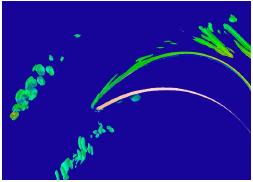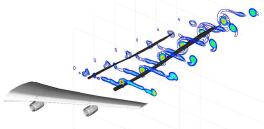Computational Fluid Dynamics

To simulate numerically internal and external flows the conservation equations of mass, momentum, and energy are solved using up-to-date algorithms implemented on high performance computers. The development of such algorithms has been the subject of various research projects at the Institute of Aerodynamics. Currently, a numerical library containing various discretization schemes, turbulence models, and solution algorithms is available. It is applied to engineering problems such as the flow field within a 4-valve piston engine and to fundamental flow phenomena such as turbulence, vortex breakdown or shear layers. Besides solutions of the Reynolds-averaged Navier-Stokes (RANS) equations for engineering tasks large-eddy simulation (LES) techniques are used for a scientific analysis of turbulent flows, since LES methods possess the capability to provide accurate small-scale results where RANS methods fail to deliver meaningful findings.

The coupling of computational fluid dynamics (CFD) solutions with computational aeroacoustics (CAA) to predict the aeroacoustic field is another important field of the Institute of Aerodynamics. This approach has been successfully applied, e.g., for the prediction of trailing-edge noise.
Increasing capabilities of the numerical methods allow to predict intricate details of the flow field, such as the interaction of engine jets with trailing edge vortices for the flow around airplane wings. The data has such a quality that it can be used in the design process of high-lift devices.

It goes without saying that CFD tools deliver force coefficients, moment coefficients, and heat loads for flows over completely different configurations, viz, cars, trains, buildings, etc. Moreover, CFD plays a valuable role in numerous applications, since it provides complete information within the computational domain. Numerical methods, however, have to be validated, especially when complex or unusual phenomena are to be investigated. The policy of the Institute of Aerodynamics is to accompany numerical simulations with experimental investigations whenever possible, such that a mutual validation is possible and the highest degree of confidence is achieved in the numerical methods.
The CFD tools are not only used in fundamental research, but also in the design process of technical devices in cooperation with various companies. To simulate flow problems for complex geometries commercial grid generation codes are available. Standard pre- and postprocessing software for a detailed analysis and presentation of the results is used. Applications include the investigation of, e.g., flows in cooling loop elements in space stations, the design of nozzles and jet apparatus in textile producing machines, optimization of winglet geometries, and flows through chip cooler elements.
